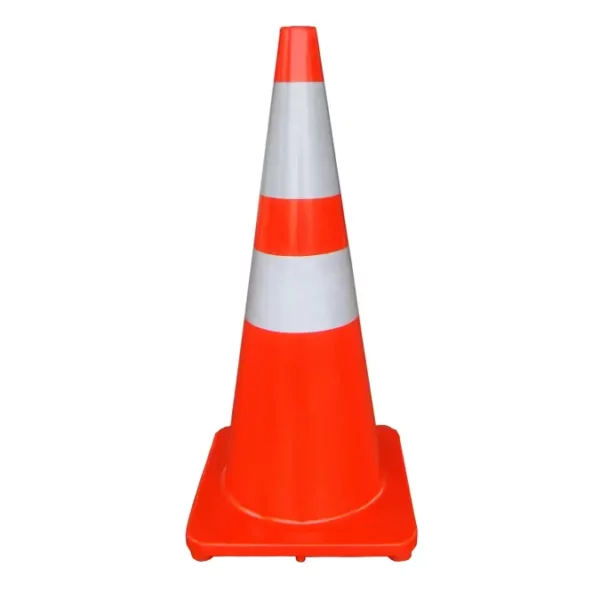The Science Behind the Orange Cone
The selection of orange for traffic safety cones is no accident. This bright, attention-grabbing color is easily noticeable against varying backdrops and weather conditions, ensuring high visibility. The choice of orange aligns with color psychology and visibility studies, highlighting its effectiveness in capturing attention and signaling caution.
Traffic cones are designed for maximum effectiveness and durability. Their conical shape offers stability against wind and passing vehicles, while the material—usually a combination of rubber and plastic—ensures durability and flexibility. These aspects make them ideal for use in various environmental conditions. Reflective strips and coatings are integral to traffic cones, especially for night-time or low-light conditions. These enhancements magnify the cone’s visibility, ensuring they are effective 24/7, regardless of lighting conditions.
Types of Orange Cones and Their Specific Uses
Different scenarios call for different types of safety cones. The standard orange cone, typically made of durable PVC, is the most commonly seen in road construction and maintenance areas. Its bright color and optional reflective strips make it highly visible, guiding drivers and signaling potential hazards or changes in traffic patterns. Collapsible cones offer portability and convenience, ideal for emergency responders and roadside breakdowns. These traffic safety cones can be easily stored in vehicles and quickly deployed when needed.
Mini cones, smaller in size, are useful for indoor applications, like marking hazards or guiding pedestrian traffic in facilities, or for outdoor athletic activities. In high-speed areas, such as highways, larger cones, often 28 to 36 inches in height, are used. These orange cones provide greater visibility from a distance and are more stable against winds and passing vehicles. They frequently feature a weighted base to enhance stability.
Traffic Cone Color Codes and Meanings
While orange is standard, traffic cones can feature different color bands or markings, each signifying a specific purpose or level of hazard. Understanding these color codes is crucial for proper interpretation and response by drivers and pedestrians.
- Orange Traffic Cones: The standard color for road cones, indicating the presence of safety hazards, commonly associated with construction sites or projects that involve road work.
- Yellow and White Cones: These cones signal that stopping or waiting in the area is not allowed.
- Blue and White Cones: When you see these cones, they typically indicate a potential overhead risk, such as the presence of power lines.
- Green and White Cones: Often found on motorways during roadworks, these cones signify an opening to access lanes.
- Red Cones: Red cones are a universal symbol of danger. They are used in areas where there is a significant hazard that could potentially lead to injury or even death.
Best Practices for Orange Cone Usage
Effective cone placement is key to safety. When using an orange cone, several best practices ensure safety and effectiveness:
Strategic Placement: Cones should be placed facing traffic, allowing drivers to see them from a distance. The FHWA recommends a minimum spacing of 30 feet between cones to create a clear path for drivers. In construction zones, heavier safety cones with reflective tape are advised, placed at least 200 feet from the work area for ample warning to drivers.
Size and Configuration Considerations: The size of the work zone and traffic volume and speed influence cone placement. On highways, cones taller than 28 inches are used, and in larger construction sites, a tapering pattern of cones is required to force traffic into the lane farthest from the work.
Visibility and Communication: Ensure that traffic safety cones are visible from a distance, especially on highways and freeways. Additional cones should indicate lane closures or changes in road direction. Communication is key in effectively using cones to guide traffic and protect pedestrians in crowded areas, such as events or concerts.
Children’s Play Areas: Reflective safety cones are helpful in residential areas, school zones, or driveways to alert motorists of children’s play areas and prevent accidents.
Orange Cone Maintenance and Inspection
Regular maintenance and inspection of orange cone safety tools are crucial for their functionality and longevity. Key aspects include:
- Checking for Wear and Tear: Regularly inspect cones for signs of damage, such as cracks, fading, or loss of reflective quality. Damaged cones should be replaced promptly.
- Cleaning: Keep cones clean to maintain visibility. Dirt and grime can be removed using soap and water. Avoid harsh chemicals that might degrade the cone material.
- Proper Storage: Store safety cones in a dry, cool place to prevent warping and fading. Stack them neatly to avoid deformation and ensure easy accessibility.
Training for Proper Orange Cone Usage
Training in the correct usage of orange safety cones is crucial, particularly for personnel in sectors such as construction, event management, and public safety. This training, often mandated by employers, equips workers with the necessary skills to effectively use cones in various situations, ensuring safety and compliance with regulatory standards. Training programs are usually conducted by professional safety organizations or in-house safety officers, depending on the company’s resources and requirements. These sessions provide comprehensive instruction on the placement, handling, and maintenance of traffic cones in different scenarios, emphasizing their role in safety and traffic management.
The frequency and nature of this training can vary based on the work environment and the introduction of new guidelines or equipment. Regular training sessions, including refresher courses, are recommended to keep workers up-to-date with the latest safety protocols and practices. These sessions are particularly important when new types of safety cones or traffic management tools are introduced, or when regulations change. Ensuring that all personnel are well-trained in the use of traffic cones not only enhances safety on site but also contributes to the overall efficiency of operations and safety culture, whether it’s road construction, managing event traffic, or ensuring public safety.
